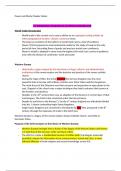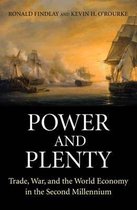Power and Plenty Chapter Notes:
C1- Introduction: Geographical and Historical Background
World Trade/Introduction
- World trade in the current era is easy to define as we segregate trading entities by
either geographical location, climate, country or more.
- The long-run evolution of the pattern of world trade raises a host of problems
- Mauro (1961) proposed an Intercontinental model for the study of trade in the early
period of time. Recording flows of goods and precious metals over continents.
- Mauro’s model is adopted in some ways throughout this work, but a series of problems
arise with the division of continents/ north and south
Western Europe
- Historically a region shaped by the inheritance of legal, cultural, and administrative
institutions of the roman empire and the doctrine and practice of the roman catholic
church.
- During the reign of Otto, the Great (936-73) the German kingdom was the most
powerful state in Europe with military victories over Slavic tribes and the Hungarians.
- The main thrust of the Ottonians was their pressure and expansion on open plains to the
east. (Support of the church was a major technique they had to enhance their power at
the frontiers and duchies.)
- Notably, in the 10th century there was an adoption of the Roman C.C. by the Slavs, Polish
and Hungary. The Czechs also converted under German pressure.
- Despite its early ties to the Roman C.C by the 6th century England was effectively divided
into abt. ½ dozen contending Anglo-Saxon kingdoms.
- Anglo-Saxon kingdoms are converted to Christianity by 686. They prospered in the 8th
century through the expansion of trade in the North Sea.
Western Europe is a legacy of the roman empire, Roman Catholic Church, and Celtic &
Germanic tribes.
Purpose of the brief synopsis on the history of Western Europe:
- Western Europe emerges from a fusion of the legacy of the Roman Empire and Roman
C.C with that of the German, Celtic and Slavic tribes.
- The effort to create a standardized version of written Latin (Carolingian miniscule)
provided a means for information to be communicated, stored and, thus, a more
efficient diffusion of both religions and secular knowledge across W.E.
,Eastern Europe
- (Includes the states of the Russian Federation, Belarus, and Ukraine. Also, it includes the
Balkan Peninsula)
- Major formative cultural influences of the region were the Byzantine Empire, Greek
Orthodox Church, thus, the area of the present state of Turkey is also included in the
region.
- Between Kiev and the northern principality of Novgorod, the Rus maintained a
profitable monopoly of the trade routes linking the Baltic and the Black Sea.
- The Bulgarian Empire also played an important role in Eastern Europe, mounting a
challenge to Byzantium.
- Page 13/14 - highlights the importance to the Bulgarians and the Slavic Greek Orthodox
Church of gaining linguistic independence from the Greek of Byzantium itself (this was a
political asset of considerable value, and it constituted a big loss to Moravia)
North Africa and Southwest Asia: The Islamic World
- Classic Core of the Islamic world, it is the region known today as the M.E.
- The region’s most valuable asset was its location relative to other world regions,
particularly before European discoveries
- The rise of Islam in the Arabian Peninsula and the Arab conquest of the region was a
decisive event in world history -> 7th century.
- The Islamic world thrived economically even through intense conflict as new crops were
introduced from the east. -> led to the growth of large new towns like Cordoba, Cairo
etc.
- In the year 750 the empire was so extensive that it was impossible to establish an
administration.
o Instead of taking the logical approach of dispersing Arab rulers among the local
population to extract taxes for maintenance and support, Umar (634-44) chose
to concentrate the Arabs in fortified garrison cities, maintaining themselves out
of cash stipends.
- In 750A.D the Umayyad Caliphate is replaced by the Abbasids and receives a regime
change in the direction of a formal and centralized Persian model.
o Notable acceleration of economic growth due to less emphasis on conquest and
military operations.
- After the death of al-Mu'tasim in 842 the Abbasi regime had some brief period of
achievement, but the long-term trend was downward.
o This was due to the difficulty in raising and maintaining the revenue to preserve
the integrity of the state
o Sawad’s revenue generated fell from 100M dirhems/year to 30M dirhams/year
from the early Abbasids to the reign of Al-Muqtadir in 918
, - The decline of Baghdad did not necessarily mean that the whole Islamic World or even
the Abbasid lands underwent the same experience.
o The fiscal imbalance of the caliphs and their protectors made them vulnerable to
external shocks leading to the rise of a new power the Seljuk Turks in the 11 th C.
- The initial unity of the empire began to disintegrate due to dynastic quarrels, religious
schism and a natural tendency that more distant segments of the center went their
separate ways.
- Ibn Tulun made himself an independent ruler in 868 and was one of the most
enlightened rulers in Egypt’s history.
o “Improving irrigation, reforming taxation in the interest of the peasant, and
generally supporting economic development in his domain.”
o Revenue of 4M dinars/year, left 10M dinars to the treasury
- The western end of the Islamic World saw Spain at the height of its power by the turn of
the millennium.
- In 750, the violent overthrow of the Abbasids led Abd al-Rahman fleeing to N.A. His
ancestry won him a following of Arabs and Berbers which allowed him to take power
rapidly in Spain and set the capital in Cordoba.
o He maintained an efficient centralized bureaucracy
- The eleventh century can be seen as a critical turning point in the destinies of all 3
caliphates, the Abbasids in the east, the Umayyads of Cordoba in the west and the
Fatimids in the center.
o Abbasids lost power to the Iranians and eventually to the Seljuk Turks
o Andalusians were squeezed by Berbers in the Maghrib and by the Christians in
the north of the I. Peninsula
o Fatimids were confined to Egypt by their failures in Syria to the east and North
Africa to the west.
o Millennial dreams of a universal Ismaili Shia state were unrealized
Central (or Inner) Asia
- A vast region in the interior of the Eurasian landmass bounded to the south by towering
mountain ranges and to the north by the Arctic tundra.
- Primary ecological region in steppe and has been the home of the nomads since ever.
o The region is roughly 6000miles from east to west and slightly less than half that
from north to south.
- Interdependence between the nomadic and sedentary peoples is one of the most
persistent themes in history.
o Likewise, are its economic systems. There is a possibility of mutual gain through
the exchange of cereals for animals and animal products
- Central Asia has served for millennia as a crossroads traversed by the flow of goods,
technical inventions, art forms, and religions.
, o Taxing the caravans that crossed the region was usually more profitable than
simply plundering them.
o Even more was trading key commodities like the silk of China westwards if this
was possible by force of arms.
- Battle of the Talas River in 751
o Chinese were defeated when their Karluk Turkic allies switched sides to the
Arabs. (War occurred as the ruler of Tashkent, an Arab client, attacked Ferghana,
a Chinese client)
o Major consequence was that Chinese prisoners taken to Samarkand taught their
captors the art of making paper.
- During the disruptive An Lu Shan rebellion of 755, the auxiliaries of the Tang, the
Uighurs (I think the Tang is a Turkic tribal confederation like the Uighurs - Uighurs
became powerful in 744 and held sway to 840.) became increasingly dependent on the
Tang for military assistance.
o In return the tang extracted a high price in terms of the familiar exchange of
horses for silk
o Also pillaging Chinese cities and provinces during the suppression of the
rebellion
South Asia:
- India: distinctive culture arose out of a synthesis between the original Dravidian
inhabitants and the Aryan pastoral nomads.
o Local deposits of iron ore gave it an edge in weaponry and forests provided
timber as well as a supply of war elephants.
- Malabar coromandel coasts in the west and east respectively had trading contacts with
the Persian Gulf and the Red Sea
- Classical age of Indian civilization considered to be during 4 th to 6th century.
o The Guptas were a powerful empire throughout that era
o Age marked by material prosperity for the ruling class and remarkable
intellectual and cultural achievements
- Arab merchants settling on the western Malabar coast gave rise to the Mappila Muslim
community
o This would later play an important role in the spread of Islam through Asia as
well as trade
- Despite being devout Buddhists, immigrants brought the Indo-Aryan caste system with
them (operating in a looser more flexible way where the main distinction was in
agricultural and nonagricultural occupations)
o Ceylon was actively involved in political conflicts of Southern Indian dynasties
o They were also involved in trade conflicts with the Burma and Sumatran trading
state of Srivijaya






